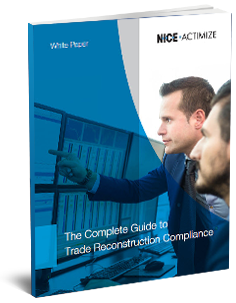How Technology Can Help with Trade Reconstruction
New technology give users the ability to automate the trade reconstruction process by aggregating, analyzing, and indexing all relevant trading data, including voice and electronic communications. Intuitive applications enable correlating and reconstructing trade and communications data in a single solution with full end-to-end Risk Case Management. Natural Language processing and content analytics capabilities allow for greater context of the communications, including both voice and electronic communications, as well as the structured data like orders and executions. The solution can analyze all data for compliance risks based on predefined risk categories resulting in automatic alerts. Analysts can easily create trade reconstructions from any alert or ad-hoc search which provides compliance departments with greater insight into all communication and transaction data which is relevant to the trading activity.
Trade Lifecycle Data (including pre and post execution)
Fundamental to a trade reconstruction is the capture of all relevant trade records and communication channels of a trader, and the subsequent storage in an archive that is accessible to the trade reconstruction process. The capture of transaction data and the ability to correlate it to the correct content is one of the most valuable elements vital to the recall of all data points related to swap identification, including pre and post trade information. Data may include counterparty, SWAP Document ID, SWAP Transition ID, SWAP deal names, stocks/currency/commodities names assisted with the SWAP, and many other possibilities.
Utilizing all available data points will improve the results of the correlation algorithm and give additional context to the transaction or trade event under investigation. Trade records can be one of the starting points for a trade reconstruction. This includes analyzing an individual trade record, an alert or even a standard communication. This is simply the threshold stage. Once all the information is captured we enhance the data with further information.
The Process
The reconstruction process consists of 6 steps, each building upon the previous action.
Step 1: Data Collection
The first step in the automated trade reconstruction process is connecting to the data that contains the trading events, including voice records, electronic communication records and trade, order and execution data. The metadata for these records are extracted and mapped to a standard data model for simple reference and basic search.
Step 2: Natural Language Processing and Text Extraction
Second, the content of the data is analyzed and prepared for content analytics in order extract meaningful information that can be used for correlations and contextual understanding of the records. Advanced speech analytics are used to convert the voice records into a transcript that can be easily analyzed and indexed. The content of the data from the communications, both voice and text, is extracted and natural language processing techniques are used to recognize the languages used in conversation and to prepare the data for further advanced content analytics.
Step 3: Content Analytics
The next step analyzes the content to enrich the data available for search, correlation and visualization. A variety of techniques are used to extract information from the content. For example, statistical methods are used to identify key phrases and terms within the content. Dictionary and advanced query methods extract entities from the recorded data. Entities such as People, Counterparties, Trade Terms, Stock Names, Commodity Names, etc. are extracted and stored as metadata with the documents. This information is key to ensuring that the data can be correlated together when a trade reconstruction is required.
Step 4: Categorization
The categorization process organizes the data by classifying the communication based on the content analytics and policy based rules. In addition to the standard metadata from the data, the enriched data from the content analytics provides the ability to categorize the data with context giving users an ability to find needed information quickly and easily.
Step 5: Correlation
The correlation process starts once an analyst identifies a scenario which requires a trade reconstruction. An event such as a trading alert, communication alert, regulatory inquiry, or a simple ad-hoc search can trigger the process for correlation. Upon the trade reconstruction request, the system will correlate data to find the most relevant information for the scenario. The NICE Actimize Trade Reconstruction solution uses all the information gathered in prior steps such as trade metadata, entity extraction, communication policies, and interaction metadata (time, counterparty etc.).
The patented correlation technique used in the process automatically recalls any interactions related to specific trade events and presents them to the user by relevancy to determine whether they should be included in the trade reconstruction.
Step 6: Time-line Review
The final phase in the process is the time-line review of the correlated events. The user queries for the data found around a trade, pulls all linked communications, and presents them in a visually well-organized interface. The result shows the user transaction data, communications, and all the pre and post execution communications as part of the reconstruction in a chorological timeline. The human element of the trade reconstruction process is now redefined - allowing for broader depth of review, improved efficiency, and greater accuracy.
From the White Paper: The Complete Guide To Trade Reconstruction Compliance
